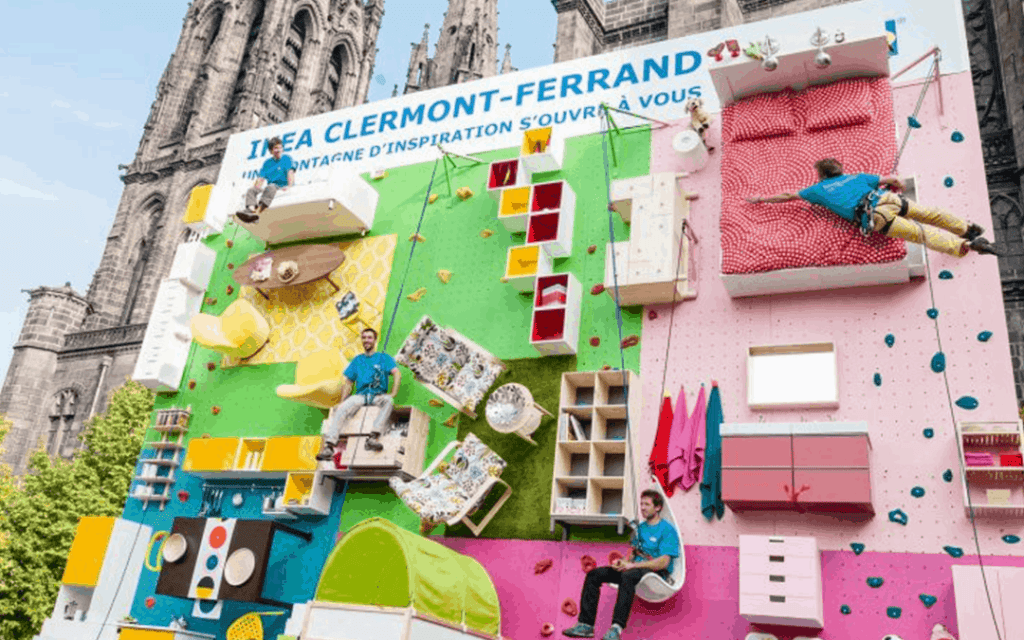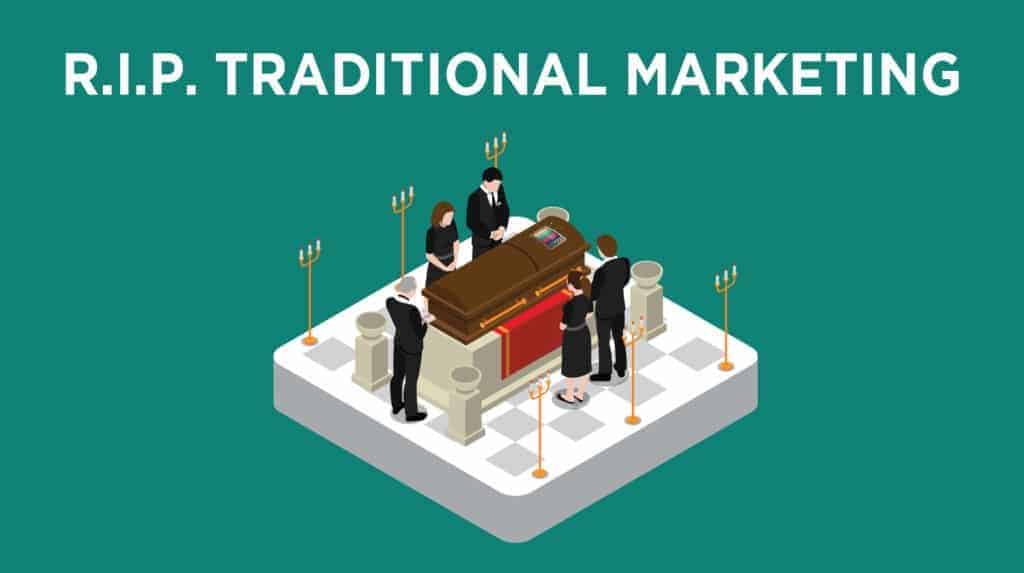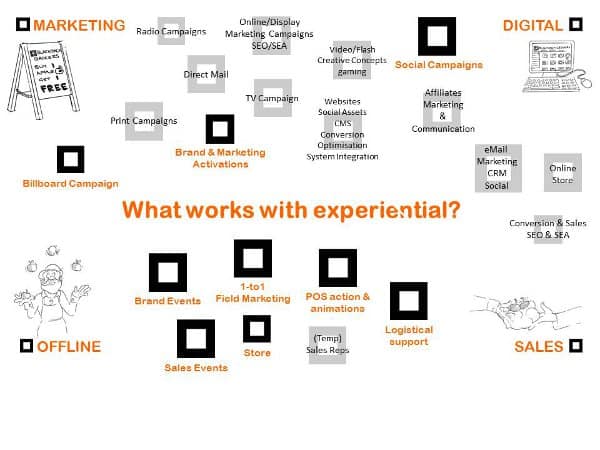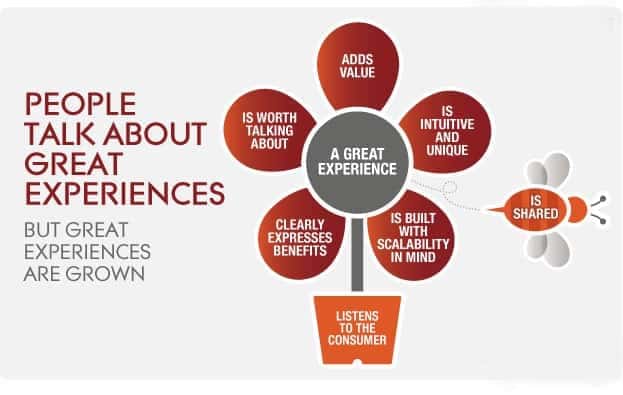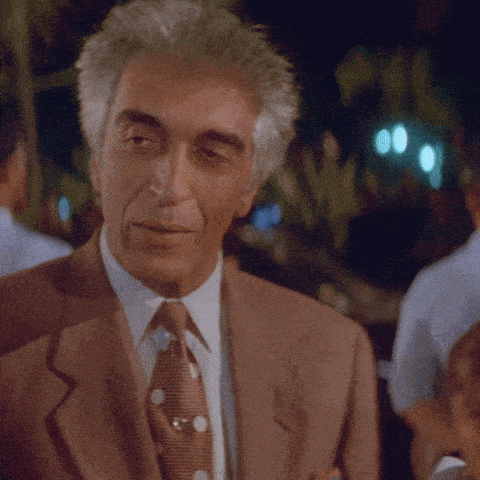An experience lasts ages. They say we don’t miss a place or a person, but what we really miss is how they made us feel. This philosophy could be further used to our advantage.
Enter experiential marketing!
The brightest marketers of this century understand that a brand is more than its products and services. A brand is what it inspires. B2B brands are often saturated in their marketing strategies.
What they churn out are cliche marketing elements that do them no good. However, if one were to churn out actual results, they would need to evoke a response among their target audience.
This can be done by experiential marketing.
Table of Contents
What is Experiential Marketing?
Experiential marketing involves delivering tangible experiences to customers and target markets.
The keyword in experiential marketing is ‘experiences’; it is not the traditional marketing that you see in newspapers and television.
Courtesy: RainFocus
When Bose set up its first store in New York City, it wanted to show to the market what it stood for.
Visitors were encouraged to attend 15-minute sessions that exposed the brand to them through clear acoustics, sharply defined music, and much more.
This article shall explain why this experiential marketing is so important for brands.
It’s all about feelings
Imagine you are invited to attend the launch of a new mobile game.
The launch party is at a fancy restaurant, which is always packed with people and has earned itself a great reputation in a short span of time.
So, you are really excited!
However, on the day of the event, it’s stuffed more than usual. You can’t find a place to sit in, the room is stuffy as the air-conditioners have given away.
Plus, your host is nowhere to be seen.
This is a really bad experience for you and you swear you would never touch this brand with even a barge pole. As a consumer, you felt unloved and the brand became an impersonal object.
Now reverse the picture.
As soon as you entered the venue, the brand owner came forward and escorted you inside, offered you a chair to sit in, and it seemed as if the whole event was meant just for you.
For a moment, it seemed to you that the brand had reached out to you, and interacted with you in various ways.
This is how an experiential marketing campaign works. The product or the service touches you in several intangible ways on several touchpoints during the course of experiential marketing.
Also known as engagement marketing, experiential marketing is a highly personalized marketing activity is used by B2C and B2B brands and marketers.
Experiential Marketing and the Psychological Impact
What we today know as experiential marketing began as something else during the turn of the 21st century.
During those years, many car and construction companies used to demonstrate their products to the public, hoping to make some direct sales.
Christopher Korody in his blog post says that at that time, people were willing to pay a premium to just experience the products displayed.
Marketers, on the other hand, competed amongst themselves to deliver those ‘out-of-the-world-experiences’ to not just make the sale, but also retain customers for a long time.
The idea was to engage customers.
A definition of experiential marketing by Pine and Gilmore in their book,’ The Experience Economy’:
In this book, consumers would pay for a new class of ‘product’ that offered an evolutionary forward step from goods, no matter how unique.
This form of experiential marketing – often used with event marketing– also extends to services marketing.
You could run an airline, a hospital, an internet services company, a trade show, or even a movie and still deliver experiential marketing.
Event marketing, let’s be clear, is just one form of experience-led marketing, as we will see later in this article.
One can see numerous companies launch their products and services through expensive brand events.
These are targeted toward various segments at the same time– distribution network, analysts, press, customers, and even employees.
But are these jaunts experiential in nature? Experts don’t concur.
Let’s have a look at some of the features of a typical experiential marketing event.
Experiential Marketing – Features
Courtesy: Identity Group
One of the most distinguishing pro points of this is that it doesn’t connect customers to a limited range of products or services, but to a brand.
While most marketing strategies target sales, experiential marketing strategies target experiences.
A successfully done experiential marketing tactic would create a positive customer experience, and thus, incline them towards trying the future products of the brand as well.
All this, simply out of the brand’s goodwill!
Experiential marketing achieves that via the following motives at its foundation:
1. It is all about creating and delivering individual experiences. These experiences are in real-time.
2. Experiential marketing transcends products and services.
3. The experience, so delivered, is compelling, memorable, and positive.
4. This experience should create a favorable inclination in the minds of the target audience toward the brand.
5. This favorable impression should result in sales, brand preference, recall, or any other metric pre-decided by the brand.
6. This is all about generating a positive ROI.
Make the most of EngageBay’s marketing automation software to deliver great experiences
Of late, experiential marketing has been redefined by the ground-breaking introduction of social media into the marketing circuit. Let’s see how.
- When an individual is moved by a particular experience, she shares her feelings with her friends, colleagues, etc.
- This sharing, it has been noticed, is done with that mass of people who have a demographic/ linguistic/ ideological, kind of affinities with the sharer.
- The extent of this sharing is measured by likes, shares, Retweets, etc.
At the moment, marketers are not sure about the level at which a brand’s virtual image or social media status helps their business.
However, a positive correlation between social media and experiential marketing has been established.
We know customer service has a huge role to play in improving the customer experience of a brand. Quick responses and accessibility across social media platforms add to customer service.
Quick and relevant customer service would improve the over-all interaction, and thus, the experience a customer has with the brand.
Let us further look into how experiential marketing deeply impacts a brand or a service.
Read also: Experiential Marketing Ideas for ‘Next Level’ Brand Campaigns
Benefits of Experiential Marketing
It’s not without any reason that many global companies use experiential marketing. Here are a few reasons why these market leaders often use these experiential marketing strategies:
1. Free publicity
This experience led marketing is not just about a positive experience.
If done right, your experiential marketing activity can fetch free publicity in newspapers, on radio, television, blogs, etc.
One of our favorite examples in this scenario is from 2015 when a Chinese company covered 14,000 square feet of its shopping area with 13 tons of candy.
The ostensible reason behind this unique marketing activity was to promote its shopping area.
In a saturated market with fierce competition, a playful and customer-pleasing approach was new.
The heap of candies attracted the masses, successfully bringing their attention to the shopping area while also providing an immersive experience.
Many Chinese newspapers and websites such as Acclaim, Inhabitat, Nice, and others covered this event for free.
This is what Pondly said; ‘A Sweet Tooth’s Delight: World’s largest Candy Art Carpet’.
2. Builds relationships and brand loyalty
Experiential marketing is capable of building relationships and brand loyalty.
It is in general human psychology to remember how a particular place or person made them feel. Their feelings shape the experience, which later shapes their future.
People who are greeted by positive and memorable experiences with a brand are more likely to prefer buying its products and remain lifelong customers.
Various studies have concluded that emotional responses are more important than the content of the ad.
Marketers should look at creating positive emotional responses through experience-based marketing in order to trigger purchases and create brand loyal customers.
Capgemini has to say the following things about emotional responses and sales:
1. 82% of all customers always buy from those companies with which they have some form of emotional linkage.
2. 81% of customers who have an emotional connection with a company will always share their experiences with family and friends.
3. 70% of customers will spend twice as much on companies with which they have an emotional attachment.
3. Creates word of mouth
A report from Data Intelligence Today says that 92% of all customers trust their peers over advertisers when it comes to buying products and services.
And it is not easy to generate that trust.
If done properly, experience marketing can create marketing buzz that can generate trust among peers.
When an experiential marketing campaign moves a targeted customer, she is more likely to share her feelings with her friends, family, and relatives.
An excellent example of experiential marketing includes Doc McStuffins.
The UK-based Disney Channel production started an experiential marketing campaign in 2013, allowing kids to meet their favorite characters while also getting their toys checked and treated in mobile clinics.
The campaign was very well-received. Also, the show successfully managed to get more publicity for its season 2. An amazing example of experiential co-branding!
4. Experiences are shareable
There is one terrific attribute of experiential marketing that other forms of marketing don’t have- shareability.
According to a Harvard Business Review Report, one of the top 10 emotional motivators is the desire to stand out from the crowd. And great companies realize the importance of experiences here.
When you deliver an out of the world experience to your customer, he is more likely to yell at his colleagues and tell them about that.
In the modern world, he will share that positive feeling or emotion with his friends.
If your customer is on social media, he will share that feeling on Instagram, Twitter, Snapchat, etc, and that sets the ball rolling.
When his friends see his message on their social feed, they share it onward and this is how buzz is created. The more buzz, the more are the chances of sales.
Like the other disciplines of marketing, this can also be classified into several types.
Types of Experience Marketing
Courtesy: Slideshare
Broadly there are 4 different types of engagement marketing designed to trigger positive emotional responses.
Please note: For maximum impact, a brand must indulge in employing all the types together. A standalone tactic might not be able to deliver the expected results or effect.
1. Retail Installations
Experiential marketing that happens inside stores is designed to lengthen the shopping activity of the shopper, and in some cases, also persuading their partners into shopping.
There may be a set of inveterate shoppers, which has an opinion on everything that happens inside their favorite stores.
This set will always be the first to test out the new arrivals (brands, extensions, etc.)
How can marketers engage with these shoppers? This is where engagement led marketing comes in.
Marketers put up attractive displays inside their stores to engage with their active shoppers and deliver a personalized experience so that the shopping activity is enhanced.
2. Brand Activations
Companies use brand activations while launching a product, service, or extension. This marketing activity is hyper-local and laser targeted toward the intended audience.
An example of brand activation is a recent marketing campaign executed under Astound Group. This company helped Starbucks launch three flavors of Teavana Iced Tea.
What Astound did was very simple; it designed several tents that had the Starbucks logo on their top. Astound also put up several ‘fruits’ atop the mobile pop-ups to attract customer attention.
When any customer stepped inside the pop-up, she could try out one of the 3 variants of Teavana.
In short, Astound did B2B experiential marketing for Starbucks. While considering b2b marketing gimmicks, one must also consider ways to incorporate experiential marketing.
Create & execute innovative & impactful marketing campaigns the EngageBay way
3. Event Marketing
A B2B company can use events to deliver customer experiences. Events generally are meant to launch a new product or a service.
This type of marketing targets several customer groups simultaneously like dealers and distributors, media, analysts, company employees, and other stakeholders.
There are too many examples to be shared here but the one that can be quoted here is the Apple conference at Cupertino that saw the unveiling of Macintosh.
That event happened in 1984 and that is when the term ‘event marketing’ was coined.
Experiential marketing events create immersive experiences for you to engage customers.
Read also: How Do Brands Win Customers With Reverse Marketing?
4. Guerrilla Marketing
Also called ‘Ambush Marketing‘, this form of experiential marketing is designed to draw out conversations about the ‘ambusher’ brand.
Guerrilla marketing has an element of surprise and is often executed by challenger brands to shock and awe their rivals.
In 2010, Budweiser, the official sponsor of FIFA World Cup, was ambushed by its rival Bavaria.
What the latter did was exceptional: Bavaria put up 36 young ladies, all dressed in bright company colors, together in one corner of the football stadium.
This was truly a guerrilla marketing activity. Budweiser’s event had been hijacked by its rival and this made many people talk about Bavaria on various platforms.
Read also: 7 Incredible Guerrilla Marketing Examples To Learn From
How are brands using experiential marketing to drive sales?
Is there a direct connection between this form of marketing and sales?
It is a difficult question to answer since sales is an outcome of various factors such as product quality, customer’s need, pricing, availability and other product or brand-specific deliverables couples with customer experience.
However, many companies, especially those which are into the travel industry, think there is indeed a connection between curating positive experiences about a brand and its sales.
According to a statistic, millennials in America look forward to their vacation and most of them spend at least 35 days of vacation each year. In 2017, the average American spent just 17 days vacationing.
Travel companies understand this and that is why are providing experience-rich vacations to the millennials.
Experiential marketing is not a stunt, let’s be clear about it. It is about getting attention plus engagement. The more out of the box your experiential elements are, the better your chances of winning your customers over!
Most companies use experience-led marketing to target millennials. It is these people who would prefer an experience over a story-less commodity, which is the case with regular products.
Travel is just one of those industries, which has benefited from the crucial benchmark that is experiential marketing.
Examples of Experiential Marketing
Over the years, experiential marketing has made its way into the minds of the brightest marketers of the generation. What came out were some experiential marketing campaigns, which transformed the customer experience.
While there are various case studies on how effective experiential co-branding is, we will be talking about the best of them all.
Following are some excellent real-life examples of experiential marketing strategies:
1. Coca Cola
A pioneer of experiential co-branding, Coca Cola has been highly focused on delivering heart-warming experiential elements to its global base.
In 2013, the beverage giant launched a campaign – Small World. The participants were strangers from India and Pakistan.
Each vending machine was equipped with a camera and a screen to assist the other participant with their orders.
India and Pakistan have always been at logger ends. However, the activity got positive and heart-warming approval not just from the randomly selected participants, but also from the netizens.
Watch it to believe it:
[su_youtube url=”https://www.youtube.com/watch?v=ts_4vOUDImE” title=”India-Pak Coca-Cola Ad”]
2. Red Bull – Stratos
This brand is synonymous with an energized spirit.
In 2012, it did something unimaginable. It sent its brand ambassador Felix Baumgartner high up in space- nearly 24 miles up – from where he jumped down to Earth.
The whole event was broadcast live on YouTube and it generated nearly 8 million views.
It was an extreme event that was designed to reaffirm Red Bull’s adherence to its core values- shock and awe.
3. Volkswagen and the Piano
In 2009, carmaker Volkswagen drew out laughs and smiles from subway commuters.
It converted one of the subway staircases in Sweden into a giant piano. Every time a commuter stepped on to this ‘piano’, the stair would let out a musical note.
People were first curious and then started enjoying themselves. That particular day, 66% more people used that particular stairway just to enjoy themselves.
Psychologists say that people are ready to do their bidding if you provide them an opportunity to enjoy themselves.
This hypothesis is also called The Fun Theory.
4. Google’s ‘Building a Better Bay Area’
The search engine company created marketing history between 2012-2014 when it let people decide how should its charity be delivered.
It set up interactive kiosks on bus stands, restaurants, inside supermarkets that talked about its charity initiatives. Each kiosk solution had several options and people were asked about their choices.
Basically, Google was empowering people to decide what set of people in need / social institutions should be given its charity.
This interactive campaign drew in 400,000 responses in just a couple of weeks.
This campaign was a success because it enabled people to use all their time to make a difference. It wasn’t a forced marketing effort.
Watch the video:
[su_youtube url=”https://www.youtube.com/watch?v=RpONKH98IZk” title=”Google Better Bay Area”]
5. Google’s #PledgeToVote Campaign
This one is closer to home. In yet another classic example of experience marketing by Google, the campaign featured India’s oldest voter, Honourable Mr. Shyam Negi braving the harsh weather of Himachal to cast his ballot.
This campaign garnered a lot of appreciation from netizens in the 2014 Lok Sabha polls, and the genius of this campaign was that to gather more information about Mr. Negi, people would have to resort to “Googling” him.
Quite clever, Google! Delivering a nostalgic experience with a subtle brand placement is what experiential marketing is all about.
Marketing by delivering experiences is personal, direct, and real-time in approach.
People are more likely to buy companies’ products and services when they are engaged emotionally by the former.
To further enhance your brand’s customer experience, you could combine this with the tips mentioned here: HOW TO DEVELOP A SUCCESSFUL CUSTOMER EXPERIENCE STRATEGY
Here are the best blog posts of marketing you should read right now:
- A Primer on Persuasive Marketing Techniques You Need to Know in 2019
- Track These 15 Marketing Metrics to Grow Your Small Business
- 13 Key Trends To Focus On In Your 2019 Marketing Strategy
- How to Conquer Silo Mentality and Break Silos in Your Business
- 9 Ways to Embrace Data-Driven Marketing for Small Businesses

